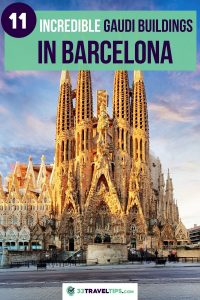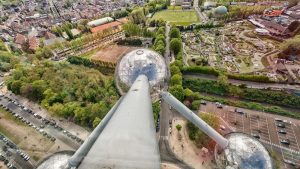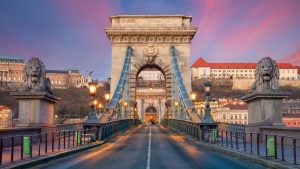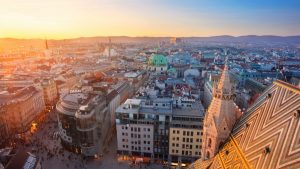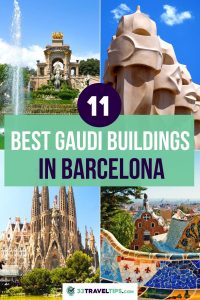
Barcelona owes much of its architectural charm to one man, Antoni Gaudí.
He designed numerous fascinating buildings in the Spanish city. From the world-famous Sagrada Familia and Casa Milá to the hidden gems, every single one of the architect’s creations is worth exploring.
In this article, you’ll find the 11 best Gaudi buildings in Barcelona.
Even if you’ve heard nothing about the Catalan architect and his distinctive style, you’ll recognize a Gaudi building when you see one. They’re unmistakable.
Some of the architect’s masterpieces were a collaboration with other talented designers. And many of the best Gaudi works were commissioned by the Spanish entrepreneur Count Eusebi Güell, hence carry his name.
Are you ready to explore the magical world of Antoni Gaudí?
Let’s dive right in!
✅ Note: This article contains affiliate links. In case you purchase something through one of these links, we may receive a small commission at no extra cost to you. Thank you for helping us keep creating the free content on this website!
1. Sagrada Familia – the Unfinished Masterpiece
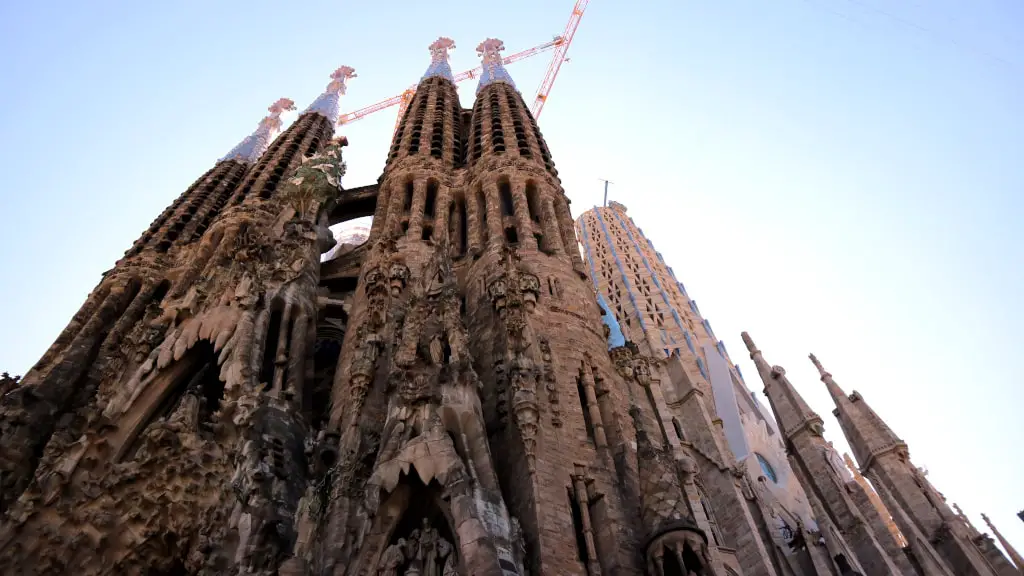
The imposing Sagrada Familia tops the list of the best Gaudi buildings in Barcelona. The unique UNESCO Heritage Site attracts close to 3,000,000 visitors yearly. However, don’t make the mistake to just marvel at its staggering exterior.
Get a ticket and explore Sagrada Familia’s astounding interior. Inside, you’ll find the true genius of Gaudí. The amount of detail he put into everything – from stained glass windows through columns to altars – is otherworldly.
If you have time, go to the top, too. The roof is equally breathtaking.
Tip: To learn all you need to know about the most recognizable Barcelona landmark, we recommend this guided tour which includes a skip-the-line entry ticket.
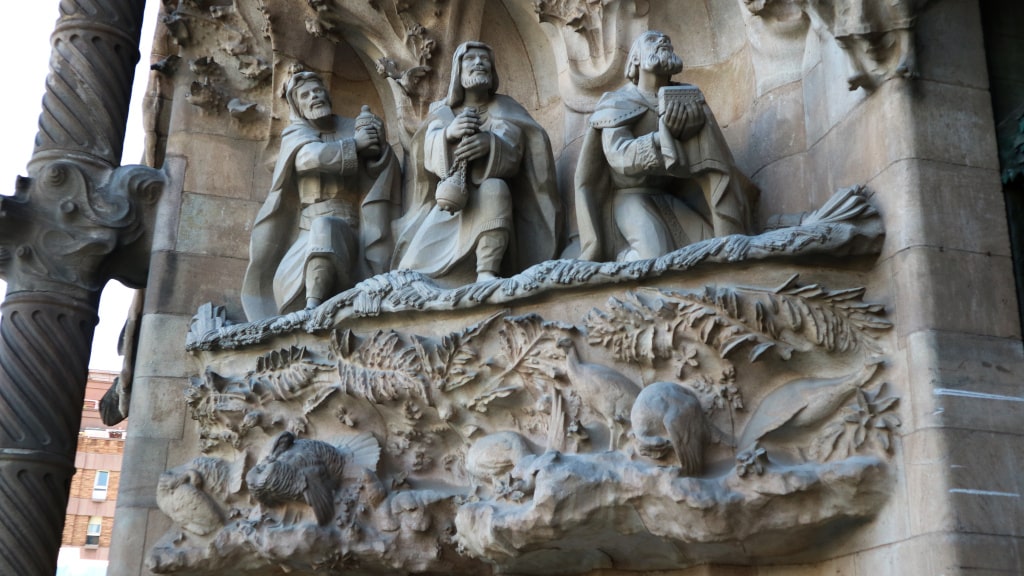
Started in 1892, the edifice epitomizes Gothic and Art Nouveau forms, as well as Gaudi’s distinctive geometric style.
1926 was an unfortunate moment for Barcelona. The beloved Catalan architect was run down by a tram near the basilica. He was buried in its crypt.
Still in construction, Sagrada Familia is expected to be completed in 2026 to honor the centenary of Antoni Gaudí’s death.
In November 2010, Pope Benedict XVI consecrated it as a sacred place, so if you’re religious, you have another reason to visit Sagrada Familia.
Neighborhood: Sagrada Família
Address: Carrer de Mallorca, 401, 08013 Barcelona, Spain
2. Casa Milá (La Pedrera) – A Sculpture or a Building?
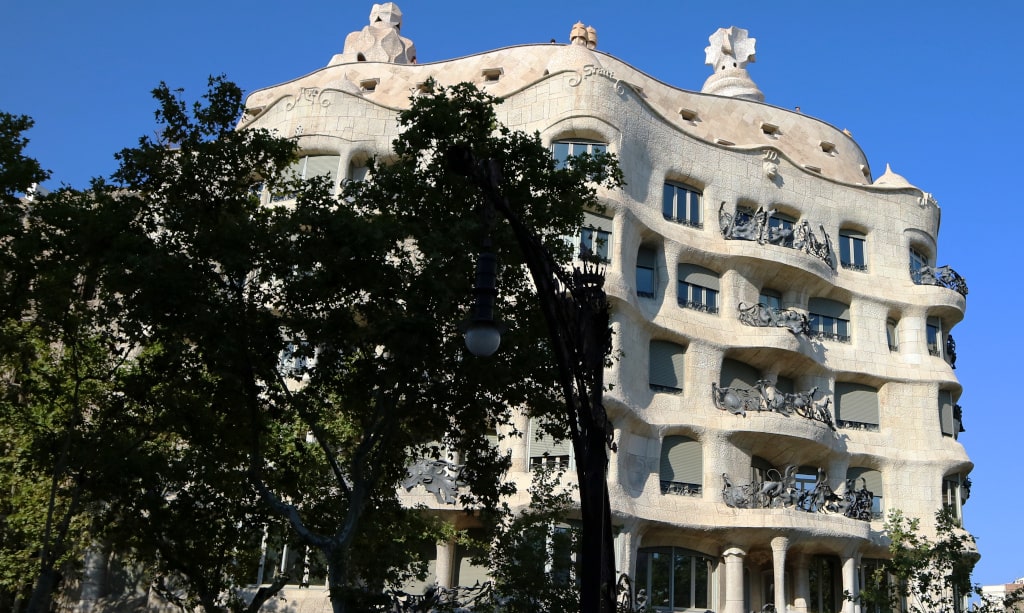
Arguably the most bizarre yet unique house of the architect, Casa Milá is among the top Gaudi buildings. In 1984, UNESCO recognized the modernist Barcelona structure as a World Heritage Site.
Also known as La Pedrera or The Stone Quarry, it’s more a sculpture than a building. Erected between 1906 and 1912, Casa Milá was the architect’s last private residence.
Due to its constructional and functional innovations, and decorative and ornamental solutions, the building is Gaudi’s most emblematic work of civic architecture.
Casa Mila’s façade features forms that are drawn from nature – from forged iron balconies to undulating stone.
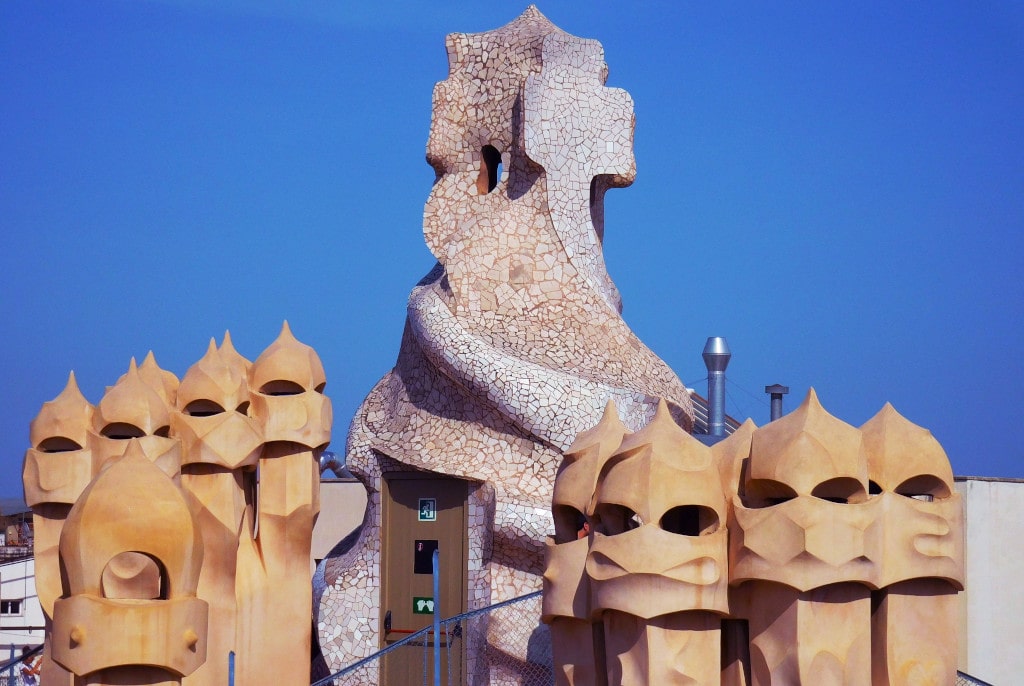
The cherry on top is the drop-dead gorgeous roof terrace where Gaudi unleashed his real genius. There, you’ll admire magnificently decorated vents, chimneys, and skylights, which mimic a city skyline.
From bottom to top, La Pedrera is a spectacular work of art. We loved our visit, and so would you.
Tip: The best way to explore Casa Mila without wasting time on queueing is to get a skip-the-line entry ticket. For a completely different experience, book the night tour of La Pedrera.
Neighborhood: Gràcia
Address: Passeig de Gràcia, 92, 08008 Barcelona, Spain
3. Casa Vicens – A Striking Combination of Hispanic and Oriental Traditions
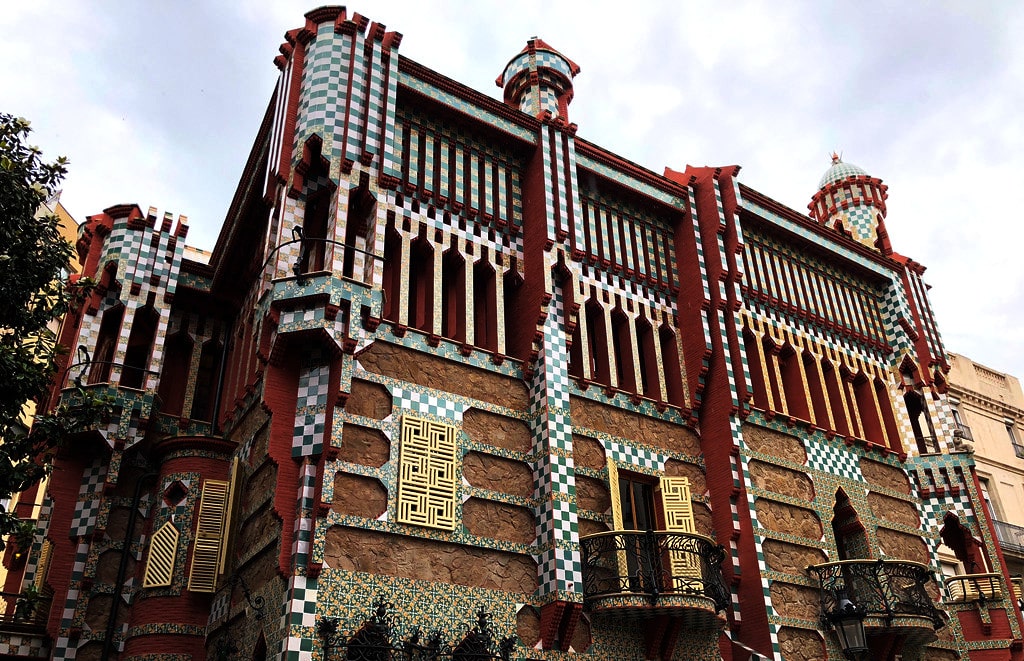
Casa Vicens is the first house, which Antoni Gaudí designed.
A reflection of Neo-Mudéjar architecture, it incorporates oriental and neoclassical styles. Gaudi broke away from traditional architecture and used a wide range of different materials, including iron, glass, concrete, and ceramic tiles.
Casa Vicens is also the first house where the Catalan architect used an oriental style, combining Hispanic and Arabic traditions.
Bare stone, coarse red bricks, as well as colored ceramic tiles in both floral and checkerboard patterns were all part of the construction, which began in January 1883.
Nowadays a museum, Casa Vicens is not only among the best Gaudi buildings in Barcelona but also one of the first Art Nouveau constructions in the world.
Bear in mind that the house is one of Barcelona’s most visited museums. Thus, it’s advisable to book your visit in advance.
Neighborhood: Gràcia
Address: Carrer de les Carolines, 20, 08012 Barcelona, Spain
4. Casa Batlló – A Dazzling Fusion of Colors and Details
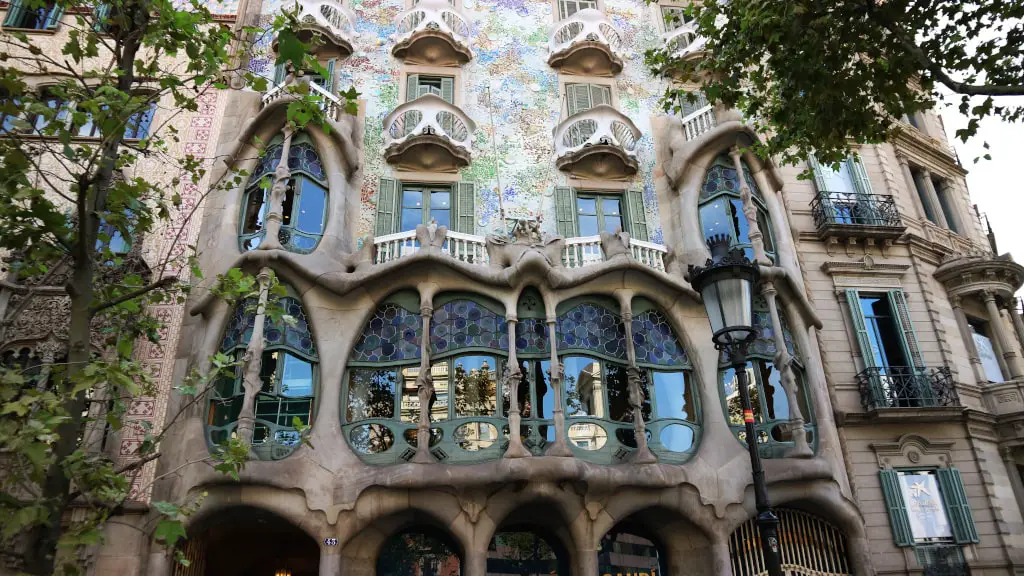
In 1877, when the house was built, Casa Batlló was a classical building without any remarkable features.
In 1900, Josep Batlló bought the house. Its design made it undesirable to buyers, but the Batlló family decided to purchase the building because of its central location.
In 1904, Mr. Batlló commissioned Gaudí to redesign his home entirely.
The result? A dazzling fusion of colors and details!
Tip: If you’re looking for a unique experience for all your senses, the interactive Casa Batlló 10-D Tour will blow your mind.
As a typical Modernism (aka Catalan Art Nouveau) example, Casa Batlló incorporates stone, forged iron, ceramics, and colorful mosaics (better known as trencadís).
Standing on Passeig de Gràcia, the house initially received stern criticism for its design that broke all traditions. Despite that, in 1906 it received the award “One of the best three buildings of the year”.
Due to its skeletal outlook, the building also goes by its local name – Casa dels Ossos (House of Bones). You’ll notice some of the house’s bone-like columns on its façade.
Neighborhood: Eixample
Address: Passeig de Gràcia, 43, 08007 Barcelona, Spain
5. Park Güell – A Walk in Fairytale Land
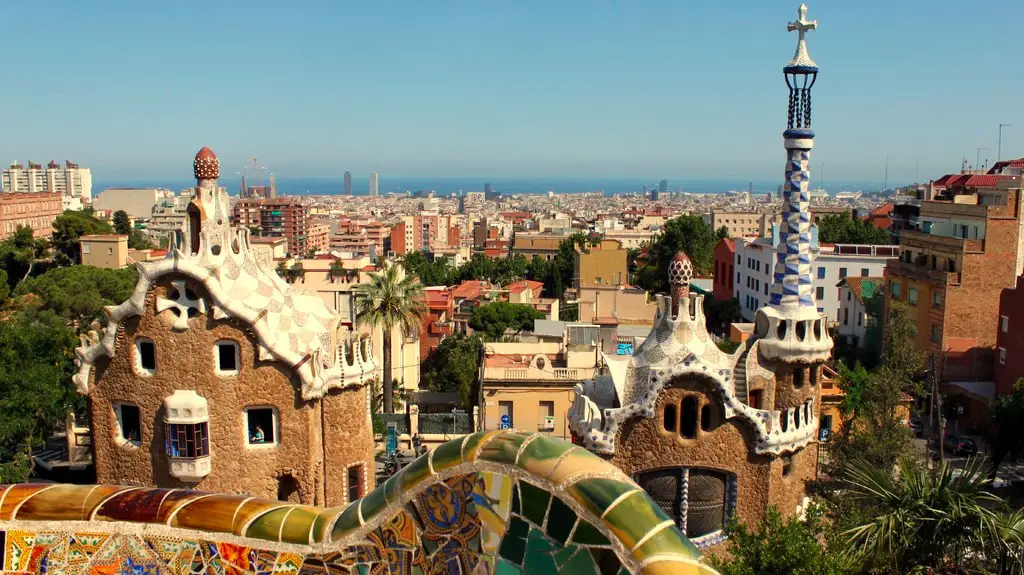
A public park system of verdant gardens and peculiar architectonic elements, the gorgeous Park Güell sits on Carmel Hill. From there, a breathtaking vista of Barcelona unfolds.
The park was constructed between 1900 and 1914. Today, it’s one of the many UNESCO Heritage Sites in Barcelona. The garden complex is also home to Gaudí’s personal house.
Park Güell is the epitome of the architect’s artistic plenitude. During the time of construction – his naturalist phase – he made use of intricate organic shapes.
Designing the park, Gaudi unveiled all his architectural wonders, producing forms that dazzle visitors with their nature-inspired beauty.
Another reason for the park’s gorgeousness is the fact that it sits in a natural park. Before construction took place, the site was a rocky hill with few trees and little vegetation.
Gaudí preserved the natural look of the park by using local stone in a way that integrates everything smoothly into the landscapes.
We highly recommend visiting the big cross at Park Güell’s highest point because it offers the best view of Barcelona and its bay.
While strolling the peculiar roads of the park, you might notice parrots, hummingbird hawk-moths, and other interesting birds.
Of all the Gaudí buildings in Barcelona, Park Güell might be the most impressive one. To learn everything about the genius’ masterpiece, we recommend joining this guided tour.
Neighborhood: La Salut
Address: Carretera del Carmel, 23, 08024 Barcelona
6. Casa Calvet – An Embodiment of Catalan Baroque
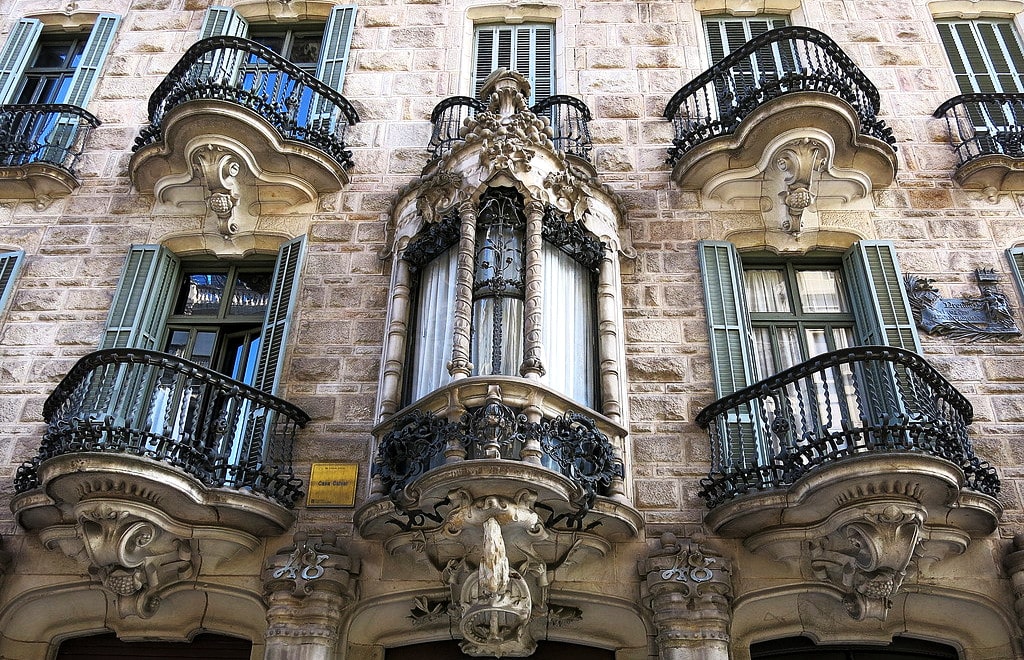
Both scholars and architects believe this is Gaudi’s most conventional masterpiece. That’s mainly because Casa Calvet needed to be “tucked in” between older structures in one of Barcelona’s most prestigious neighborhoods.
As one of the earliest Gaudi buildings in Barcelona, Casa Calvet is more conservative than it is modernistic. Despite that, many of the elements reveal Gaudi’s Art Nouveau style.
For instance, the façade terminates with a curve, while the attic balconies look like they’ve been taken out of a fairy tale.
Construction took place in 1898-1900. Casa Calvet was built from stone that was quarried straight from Montjuïc. Splendid wrought iron adorns the house’s peculiar balconies.
Nowadays, the ground floor is home to a restaurant where you can marvel at arches with vine-shaped reliefs, granite Solomonic columns, and the typical Catalan ceiling.
On the roof, you can find crosses made from bent iron that are surrounded by stone ornaments.
The crème-de-la-crème are the three Calvet saints – Saint Peter the Martyr (namesake of Sant Pere Màrtir – the house’s owner), Saint Genesius of Arles, and Saint Genesius of Rome.
Neighborhood: Eixample
Address: Carrer Sant Marc, 57, 08253 Barcelona, Spain
7. Church of Colònia Güell – Not Your Regular Temple
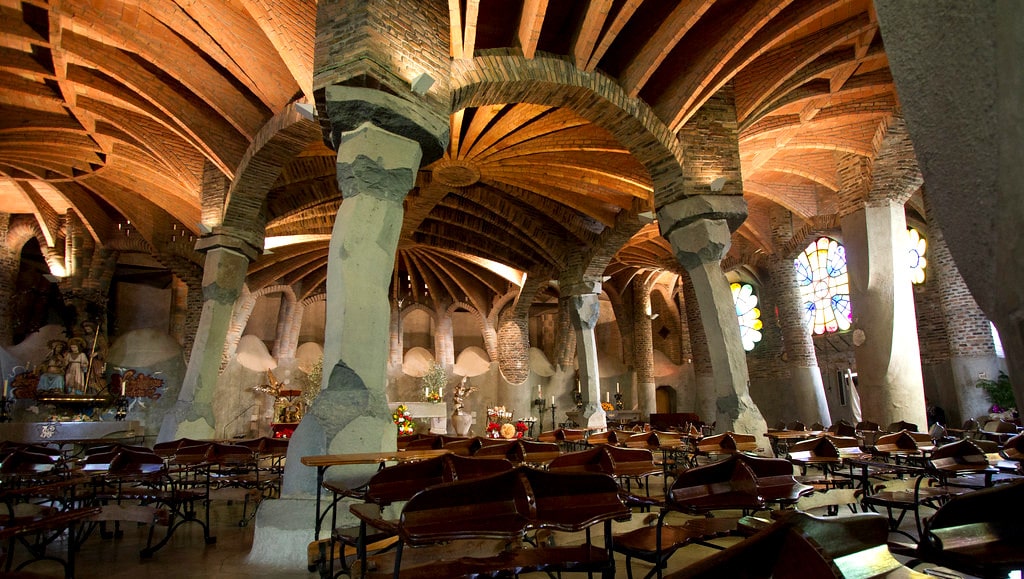
The church also goes by its Catalan name Cripta de la Colònia Güell and is often referred to as Gaudí’s Crypt.
Started as a place of worship and still unfinished, it sits on a hillside in the suburb of Santa Coloma de Cervelló near Barcelona. So, if you want to leave the city limits but don’t have enough time to add a day trip from Barcelona to your itinerary, visiting the Church of Colònia Güell is a nice alternative.
It’s considered one of the best Gaudi buildings, and it’s a UNESCO World Heritage Site.
The church’s crypt is the only portion that was fully completed. What’s striking about it is that since construction was on a hillside, the crypt was partially built below ground. And even better – it looks like it belongs to the surrounding nature.
As you can imagine, there’s not a lot of light entering as it’s partially an underground structure. However, 22 stained glass windows let colorful sunrays inside.
While the chapel remains incomplete, it’s a crucial aspect of the Church of Colònia Güell because its design resembles that of La Sagrada Familia.
Construction commenced in 1908, but Gaudi halted it due to the demise of Count Güell.
If you like religious buildings, then the Church of Colònia Güell should be one of the must-visit Gaudi buildings on your list. You can explore it on this tour with an audioguide.
Neighborhood: Santa Coloma de Cervelló
Address: Carrer Claudi Güell, 08690 La Colònia Güell, Barcelona, Spain
8. Palau Güell – Domestic Architecture in an Art Nouveau Setting
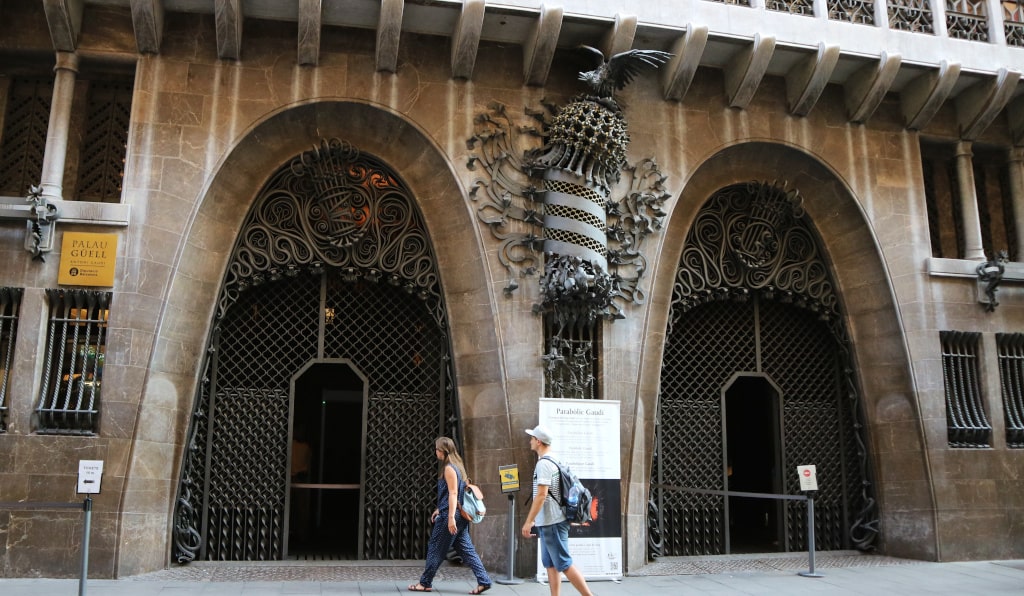
Gaudi designed and built Palau Güell (Güell Palace) for the industrial magnate Eusebi Güell between 1886 and 1888.
The mansion is a fantastic combination of old-fashioned magnificence and conventional modernism.
You’ll find the palace tucked into a tiny street in El Raval neighborhood which is also one of the best areas to stay in Barcelona.
In 1969, the Spanish government declared the building a historical-artistic monument, while in 1984, UNESCO added it to its World Heritage Sites list.
These recognitions are no wonder, considering the amount of detail and facets Palau Güell prides itself on.
Considered one of the top Gaudi buildings in Barcelona, it’s noteworthy for the creative conception of light and space. For the construction, the genius architect created brilliant expressive forms using only traditional materials like wood, stone, glass, pottery, and wrought iron.
Güell Palace contains the spirit of Gaudí’s later masterpieces and has a central role in understanding his peculiar architectural style.
We highly recommend visiting this building as a superb example of domestic architecture in an Art Nouveau setting.
Neighborhood: El Raval
Address: Carrer Nou de la Rambla, 3-5, 08001 Barcelona, Spain
9. Torre Bellesguard (Casa Figueres) – A Truly Beautiful View
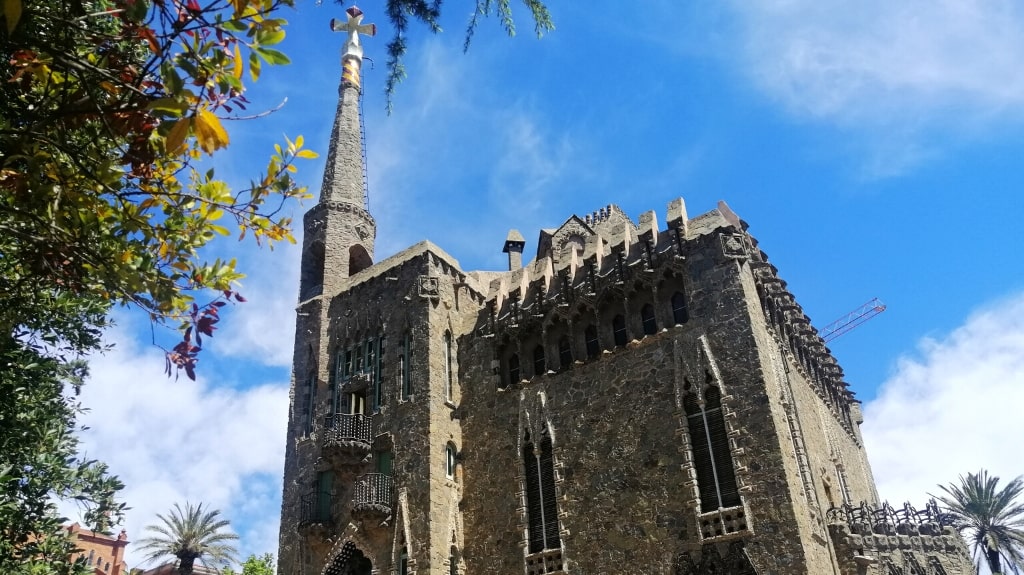
If you’re a fan of simplistic buildings, the Torre Bellesguard, also known as Casa Figueres, will surely strike your fancy. Antoni Gaudi erected the structure between 1900 and 1909 mainly from bricks and stones.
The exterior follows predominantly a neo-Gothic style, which is in line with the original medieval castle Martin I that once existed at the site. Visiting the resulting masterpiece is one of the most unusual things to do in Barcelona.
The estate’s interior has a Modernist design where Gaudi’s true naturalistic style shines in all its glory. Colored glass, white plastered walls, and iron details all flirt with each other inside Casa Figueres.
Gaudi not only superbly blended Neogothic style and Art Nouveau. He also managed to restore the medieval palace’s remnants that are nowadays part of the mansion’s grounds.
Once you enter, pay particular attention to the ceilings. Most of them represent the so-called Catalan arch, which uses a structure of overlaid layers of bricks.
At the garden’s entrance, you can admire the Crown of Aragon’s shield which features a rising sun.
In Catalan, the name Bellesguard means “A Beautiful View”. You’ll totally agree with this name once you’ve seen the dazzling panorama of Barcelona from the estate.
Neighborhood: Sant Gervasi – La Bonanova
Address: Carrer de Bellesguard, 20, 08022 Barcelona, Spain
10. Güell Pavilions – A Spectacular Example of Modernista Architecture

Count Eusebi Güell had a mansion in Les Corts district, which is now part of Barcelona. The complex of buildings known as Güell Pavilions (Catalan: Pavellons Güell) needed redesigning. The count commissioned the task to Gaudi.
His job was not only to remodel the estate but also to construct a perimeter wall with gates. Gaudi’s proposal was Orientalist design with hints of Mudejar Art. The plan consisted of an ashlar wall, along with several gates.
The most impressive part of Finca Güell (another name for the Pavilions) is the main gate – a wrought-iron grille in the form of an attacking dragon. The mind-blowing entrance represents Ladon, the guardian dragon of the Garden of Hesperides. In Greek mythology, Hercules defeated Ladon as part of his twelve labors.
As one of the most captivating Gaudi buildings in Barcelona, Pavellons Güell consists of a stable, gatehouses, and a longeing ring.
The Catalan architect also helped with the design of the mansion’s gardens. He constructed a pergola and two fountains and planted Mediterranean species, including pines, palms, magnolias, and eucalyptus.
You can find the “Fountain of Hercules” near the Palau Reial de Pedralbes.
Neighborhood: Pedralbes
Address: Av. de Pedralbes, 7, 08034 Barcelona, Spain
11. Cascada Fountain at Parc de la Ciutadella – A Refreshing Getaway from the Heat
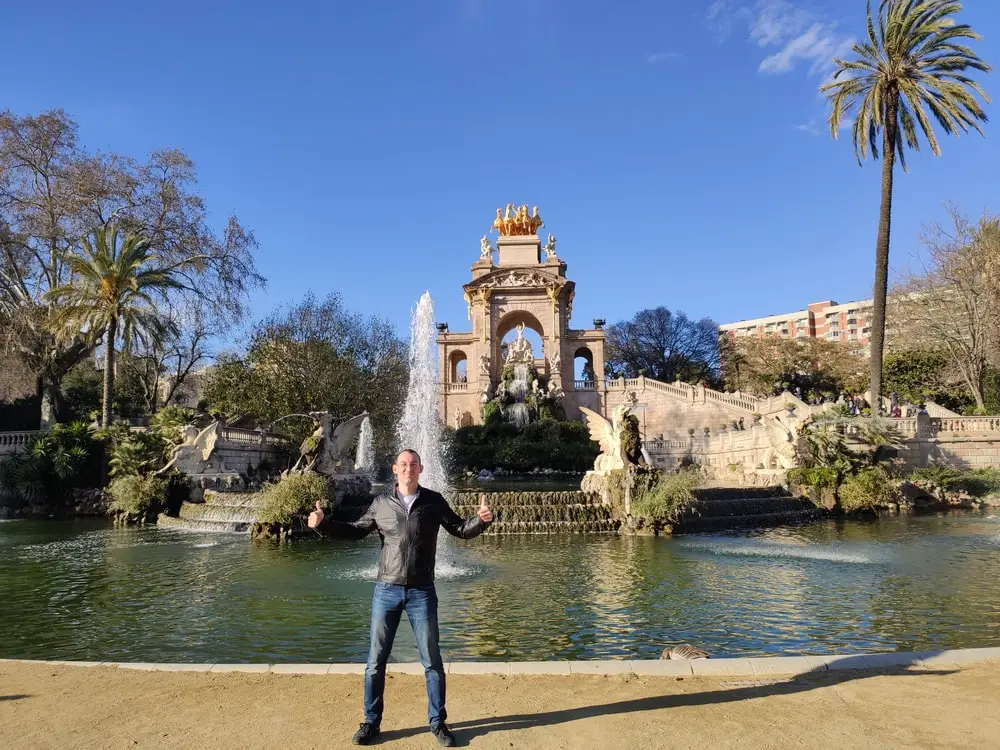
Cascada Fountain cozily sits in one of Barcelona’s most picturesque parks – Parc de la Ciutadella (Citadel Park).
In the design and construction of Cascada Monumental, Gaudi had a partial role.
At the time – the beginning of the 1880s – he was working at the studio of Josep Fontserè. Gaudi corrected a task that had been given to another student – designing the grand, new fountain’s water tank and hydraulics.
Besides two stone medallions with lizards in the fountain’s upper section, Gaudi’s role was mainly behind the scenes. Cascada Monumental loosely resembles the Trevi Fountain in Rome. Many Catalan artists also helped with the fountain’s design, which consists of dragons, watersprouts, and stone-carved clams.
The Cascada Fountain’s highlight is the gold statue of Aurora riding four horses. In Roman mythology, she represents the dawn.
Whether you’re exploring the park or just passing by, one thing is for sure. The fountain’s splendor will stop you in your tracks.
The entrance to the Parc de la Ciutadella is free, so we highly recommend visiting Cascada Fountain.
Neighborhood: La Ribera
Address: Parc de la Ciutadella, Passeig de Picasso, 21, 08003 Barcelona, Spain
Which One of the Best Gaudi Buildings in Barcelona, Spain Is Your Favorite?
There you have it – the 11 best Gaudi buildings in Barcelona. Each of these drop-dead beautiful creations impresses with its own charm and peculiarity.
We’re sure you’ll find at least a few to satisfy your architectural cravings.
Now, tell us:
Which Gaudi buildings are you visiting when you go to Barcelona?
If you’ve already been to the magnificent Catalan capital, which ones have you already marveled at?

